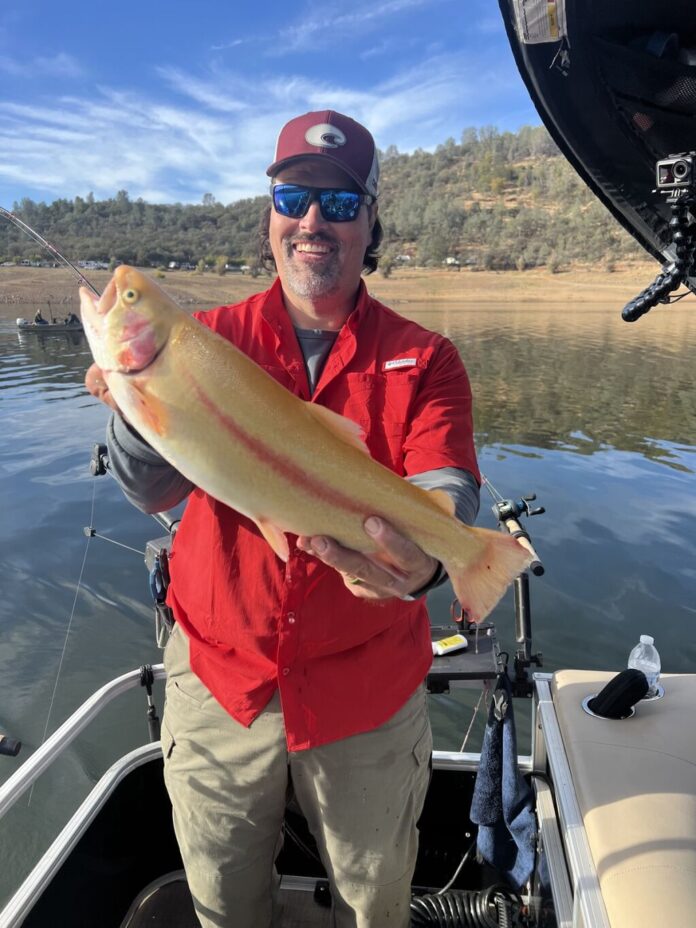For anglers the allure of the Sierra foothills is access to fishing 12 months of the year. We have the ocean three hours to the west, the high Sierra an hour to the east, and all manner of opportunities in the Sacramento Valley from Shasta down to the Delta. Currently we are snowed out of most of the high country but the foothills have a lot to offer. The best local fishing for trout is to be found at Collins Lake, a half an hour west off Highway 20.
Collins is an irrigation reservoir just below the 1,000 foot elevation. It has self-sustaining populations of bass crappie and catfish. What it is known for in the cool weather months is trout fishing. It is one of the most heavily stocked trout lakes in the north state. This year they have added something new, “Lightning Trout”. This has created a lot of excitement in the angling community.
Lightning trout are a genetic mutation of a rainbow trout. They started in the eastern U.S. They have been brought to California and Mt. Lassen Fish Hatchery has been raising them. These fish are rainbow trout in all respects except color. The flesh is quite red and is said to be good table fare. Collins has been purchasing them as trophy trout and they are commonly in the 4 to 6 pound category.
Currently the conditions for trout fishing at Collins Lake are ideal. The water is 55 degrees, down from the low 60’s two weeks ago. The trout can be found as deep as 40 to 50 feet but these are not feeding fish and they do not respond to anglers. The actively feeding fish are in the top 10 feet of the water column and close to shore. Shore anglers are doing well with power bait in water no deeper than 10′.
The boat anglers are doing well trolling small offerings from the surface down to 10 feet. The best conditions feature a ripple on the surface which obscures the rainbow trout from predators, unless they are a bright orange. Guide Cal Kellog posed a question in a recent conversation. He was saying that he can see the Lightning trout near the surface, as far out as 30 yards from the boat due to their size and bright coloration. How many standard rainbow trout with their camouflage color are we not seeing? Based on fishing results, most are going unseen.
Cal reports the most effective trolling lures for him have been small soft plastic worms about 3” long and the diameter of a piece of spaghetti. The colors have centered on hot neon, with pink followed by orange being the most productive. What has not been working have been larger lures like spoons or plugs. The trout have been feeding on bait fish including shad, bluegill and crappie. The bluegill and crappie are only the size of your thumb nail. The shad can be an inch or a bit more. Yes, size does matter.
The other tip Cal offered was the trout are close to shore in water 10′ or less. Out over deep water you can see fish in the depths but these are not actively feeding and are tough to catch.
This pattern will last until we get some serious rain. If we get a lot of rain the lake can get muddy and then the fishing can slow down. Right now with our fair weather the fishing should continue to be good.
For anglers who want to fish rivers, Tom Page, Reel Angler’s Fly Shop, has been guiding the Lower Yuba River and doing well catching steelhead using artificial egg patterns, downstream of spawning salmon. The salmon spawn was later this year due to low and warm river flows. We are experiencing fishing that should have come on in late October. Beginning December 1 the river above the Highway 20 Bridge reopens to fishing. It has been closed since September to protect spawning salmon.
The Sacramento River salmon fishing this fall has been poor due to low warm water. There is the late fall run which comes on just after Thanksgiving. This run features some of the largest individual fish that swim up the river. There are reports recently from ocean anglers catching large salmon outside the Golden Gate. Early December is prime time for this fishery.
For those river anglers willing to drive three hours, the Trinity River west of Redding has decent steelhead fishing. The steelhead are concentrated below the tributaries. There has not been enough precipitation for these spawning tributaries to begin flowing and these fish will be in these locations until the water rises.
There is always some place to wet a line within a short drive from western Nevada County. Get out while the weather is good.
Denis Peirce writes a fishing column for The Union’s Outdoors section and is host of “The KNCO Fishing & Outdoor Report,” which airs 6-7 p.m. Fridays and 5-6 a.m. Saturdays on 830-AM radio. Contact him via his website at http://www.trollingflies.com
Submitted by Cal Kellog
Submitted by Cal Kellog
Credit: Source link































